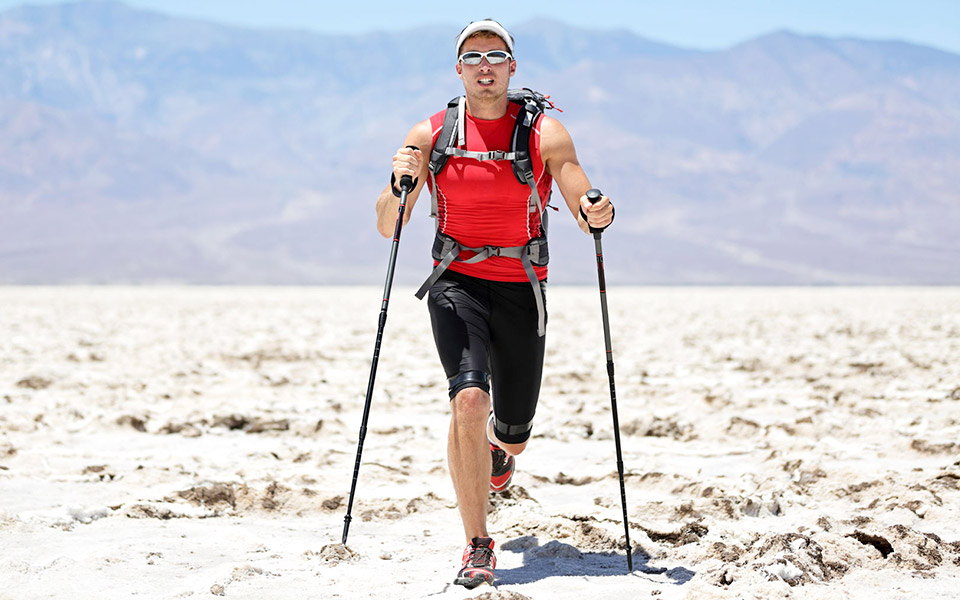If you are thinking of running an ultra marathon, you’ve got a lot of work cut out for you to prepare for the high-endurance event, but the end result will be such an uplifting experience, you’ll soon forget about the daunting work you undertook to ready your body and your mind for this extreme challenge. To help you prepare for your next ultra, this alphabet of terms includes advice, precautions, tips and advice—everything you need to finish up with the bragging rights you deserve!
A is for Altitude. Your chances of encountering higher altitudes than you face when you run regular marathons are good, so make it a practice to include in your training regimen a variety of altitudes that approximate heights you expect to encounter during your race. Training at different altitudes gives your lungs and body time to adjust and you will thank your wise self for adding them to your conditioning schedule.

B is for Blisters. One of the biggest enemies an ultra marathon runner can confront, because they can literally stop you in your tracks. Competitors who have not properly prepared their feet for an extended run experience are the most likely to suffer from painful blisters, so take shoe fit, socks, foot taping and lubricant precautions to avoid having to face this situation.
C is for Coach. Lucky is the ultra marathon runner who can count on a friend or colleague to act as his/her coach, because with the help of a formal or informal mentor, your motivation, stamina, perspective and drive can all be channeled properly through the eyes of a person who is as eager to see you achieve success as you are.
D is for Dirt Roads. One of the three types of running trails selected by ultra marathon organisers for extreme events so that competitors are exposed to a variety of surfaces. This may also include mountain paths and paved roads to test a runner’s versatility.
E is for Endurance. The single most important quality you can develop as you train over increasingly long times and distances to build your fortitude and cement your personal resolution to stay the course to the ultra marathon’s finish line.
F is for Flexibility. A word that has nothing to do with joints and muscles as you train for your ultra marathon! It’s important to maintain a flexible training schedule to account for unexpected circumstances, like weather, injuries and social obligations that pop up when you least expect them. Rigid preparation protocols can result in a bad performance once you leave the start line.
G is for Gear. The gear you bring along to undertake an ultra marathon differs from that of other race types because you may be required to tote a flashlight, hat, rain poncho or energy bars to sustain your effort and keep you safe. Count on collection stations along the route so you can trash refuse as you go.

H is for Hardships. Any ultra marathon runner who fails to anticipate hardships during one of these arduous competitions needs a bit of a mind adjustment before registering for this type of race. Says Byron Powell, a leading ultra marathoner, it’s important to remember that hardships “eventually get better”.
I is for the International Association of Ultrarunners. A professional organisation tasked with planning various events around the globe that are slated for runners who possess all sorts of athletic skills, but particularly those who favour a more extreme style of marathon running.
J is for Justification. The solid reason you decide to attempt an ultra marathon against family or friends’ advice and admonitions. Naysayers rarely have the courage it takes to attempt big challenges like an ultra, but you do, so never put yourself into a position where you have to justify your reasons for competing. Just do it!
K is for Kilometres. The distance measurement used by a preponderance of nations hosting running events who remain on the metric system. Kilometre calculations are important in determining whether a race can truly be classified as an ultra marathon.
L is for Listening. Not to the crowd, but to your body. When you listen to signals emanating from your body and brain you become a wiser ultra marathon participant because you stand a better chance of avoiding injury as a result of “overdoing” your training—particularly when you are under the most pressure.
M is for Mileage. An ultra requires you to build a respectable base by increasing your capacity over time. Experts recommend not exceeding the addition of 10 percent more mileage per week so you gradually ease into longer distances without suffering training aches and pains.

N is for Nerve. Does it take plenty of nerve to run an ultra marathon? Ask those who have overcome their worst fears to compete. Find the word ‘nerve’ in the dictionary and you’ll learn that it signifies courage, bravery and guts—exactly the qualities you need to challenge yourself to so intense a competition.
O is for Organised. Ultra runners need to organise everything from their training schedules to diet plans, gear to itinerary. For the organiser, a well organised race is important to the racers. For participants, if you fail to plan, you are planning to fail.
P is for Preconceptions. Especially those that can arise when preparing for one’s first ultra marathon. Allowing your imagination to tap on your insecurities can undermine endurance race preparation, so when your mind begins to ruminate over preconceptions, a mantra like “I can do this!” can end those thoughts fast.
Q is for Queasy. A common symptom seen in women who run and train for ultra-marathons. Scientists note that women who getting queasy and exhibit other GI distress symptoms tend to be young women and/or those with higher body mass indices. Probiotics are often prescribed by doctors to nip queasy GI upsets in the bud.
R is for Running Shoes. Given the extreme distance an ultra marathoner travels, it’s wise to assess one’s running shoes early in the planning process. Proper running shoes should be broken in, but not so worn they don’t hold up well throughout the event. Expect your feet to swell, so remember this rhyme: always wear a pair with a little room to spare.
S is for Stress. Expect to experience stress as you get closer to your ultra marathon because you’re likely putting a lot of pressure on yourself to live up to your personal expectations. Share your worries, concerns and pent-up tension with people closest to you so they are given the opportunity to help alleviate the stress you feel.
T is for Training. That extends to every aspect of your life. In addition to acclimating your body to longer runs, get into the habit of consuming extra calories and focusing on liquid consumption so you don’t risk gastrointestinal problems. It’s wise to stay away from new and unproven foods and liquids when you train, too.
U is for Ultra Marathons. A distinct competitive event that requires a runner to push the boundaries of her mental and physical capacities. To be considered an ultra, the race requires participants to run or walk more than 42.195 km—longer than a traditional marathon. Extreme trail challenges may also identify an ultra marathon.
V is for Variety. The non-race training workouts you undertake to balance your conditioning regimen so your upper body is as strong as the legs you’re working to endure the rigours of an ultra marathon. When you swim, weight train or undertake a machine circuit, mix it up so your entire body is prepared for the big day.

W is for Weight Gain. As experienced ultra marathoners can tell you, a slight weight gain can occur when a competitor begins tapering training to expend toxins that build up from a bold and rigorous conditioning program. Weight gain can be beneficial; you need as much reserve energy as possible when running this event.
X is for the Xenial. Ultra marathon participants will travel to different countries and places for their races. The organisers of such races are usually very hospitable and would help the participants with anything possible together from the locals to make sure they will have a great race experience.
Y is for Your Own Race. It matters not how many competitors queue up at the start line; you’ll still be running your own race and that means exploring your ultra-marathon for what it is: an arduous, often non-competitive experience that challenges every person to focus on his or her own physical and psychological journey.
Z is for Zest. A level of enthusiasm that is exhibited by men and women as they approach ultra marathons. Runners who relish their sport and are keen on undertaking as many ultras as time and money permit exhibit a gusto that’s contagious. How to test your zest? Do an enthusiasm check every time you prepare to train or run!
The ABCs of Ultra Running
This alphabet only touches the surface of terms and situations an ultra marathoner confronts when preparing for so rigorous an experience, and we’re curious about your reaction to the letter “P is for Preconceptions”.
What preconceptions did you have before you ran your first ultra that proved to be erroneous? If you’ve never attempted an ultra, can you tell us if any preconceptions are stopping you from taking the leap?




